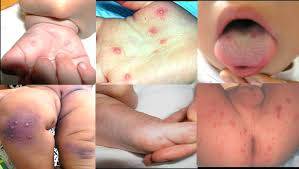
MOH Singapore – Hand, Foot & Mouth Disease
Source: http://www.youtube.com/watch?feature=player_embedded&v=HiYt9Izv-24
The Ministry would like to stress the importance of maintaining high standards of personal and environmental hygiene to minimise the risk of HFMD. Parents should ensure that their children adopt the following good practices:
- Wash hands with soap before eating and after going to the toilet;
- Cover mouth and nose with a tissue when coughing or sneezing, and throw the tissue away into a bin immediately;
- Do not share eating utensils.
Parents should also ensure that toys or appliances that are contaminated by nasal or oral secretions should be cleaned before they are used again.
Parents should consult a doctor early if their child has fever, mouth ulcers and rashes on the palms, soles or buttocks. Children with HFMD should remain at home until all the blisters have dried up. During this period, contact with other children should be avoided until the child recovers. The child should not be brought to any public or crowded places. Proper hygiene should also be practised at home so as to prevent transmission to other family members.
What is Hand, Foot & Mouth Disease?
Hand, foot and mouth disease (HFMD) is a human syndrome caused by intestinal viruses of the picornaviridae family. The most common strains causing HFMD are coxsackie A virus A16 and enterovirus 71 (EV-71), but may be caused by various strains of coxsackievirus or enterovirus.
HFMD is a common and highly contagious viral infection that typically causes a mild, self-limited febrile illness followed by a maculopapular rash that may involve the skin of the hands, feet, and oral cavity. HFMD is fairly common and typically affects infants and children, but may affect immunocompetent adults on occasion. The viruses that cause HFMD are spread through direct contact with the mucus, saliva, or feces of an infected person. HFMD typically occurs in small epidemics in nursery schools or kindergartens, usually during the summer and autumn months. The usual incubation period is 3–6 days.
HFMD should not be confused with foot-and-mouth disease (also known as hoof-and-mouth disease), a distinct viral disease known to affect sheep, cattle, and swine (both diseases are caused by members of the picornaviridae family) but is not transmitted between animals and humans.
Signs and symptoms
Early prodromal symptoms are likely to be fever often followed by a sore throat. Loss of appetite and general malaise may also occur. Between one and two days after the onset of fever, painful sores (lesions) may appear in the mouth, throat, or both. A rash (vesicle) may become evident on the hands, feet, mouth, tongue, inside of the cheeks, and occasionally the buttocks (but generally, the rash on the buttocks will be caused by the diarrhea). HFMD usually resolves on its own after 7-10 days.
- Fever
- Fatigue
- Malaise
- Sore throat
- Painful perioral, intraoral, nasal, or facial lesions, ulcers or blisters
- Maculopapular rash, followed by vesicular sores with blisters on palms of hand, soles of feet, buttocks, and sometimes on the lips. The rash is rarely itchy for children, but can be extremely itchy for adults
- Sores or blisters may be present on the buttocks of small children and infants
- Irritability in infants and toddlers
- Loss of appetite
- Diarrhea
- Diagnosis
A diagnosis usually can be made by the presenting signs and symptoms alone. If the diagnosis is unclear, a throat swab or stool specimen may be taken to identify the virus by culture.The common incubation period (the time between infection and onset of symptoms) ranges from three to six days.
How HFMD Spreads
HFMD is spread from person to person by direct contact with the nasal discharge, saliva, faeces, and fluids from the rash of an infected person.
A person infected with HFMD is most contagious during the duration of the illness. Although the virus may continue to persist in the stool for several weeks after infection, the person generally becomes much less contagious when the illness resolves. Nonetheless, good personal and environmental hygiene must continue to be maintained.
Treatment
There is no specific treatment besides relief of symptoms. Treatment with antibiotics is not effective and is not indicated.
There is no HFMD vaccine currently available.
For more information on HFMD, please see the FAQs on MOH website at http://www.pqms.moh.gov.sg/apps/fcd_faqmain.aspx, or the Infection Control Guidelines for Schools and Childcare Centres.
MOH also publishes a weekly bulletin on the local infectious disease situation here.









